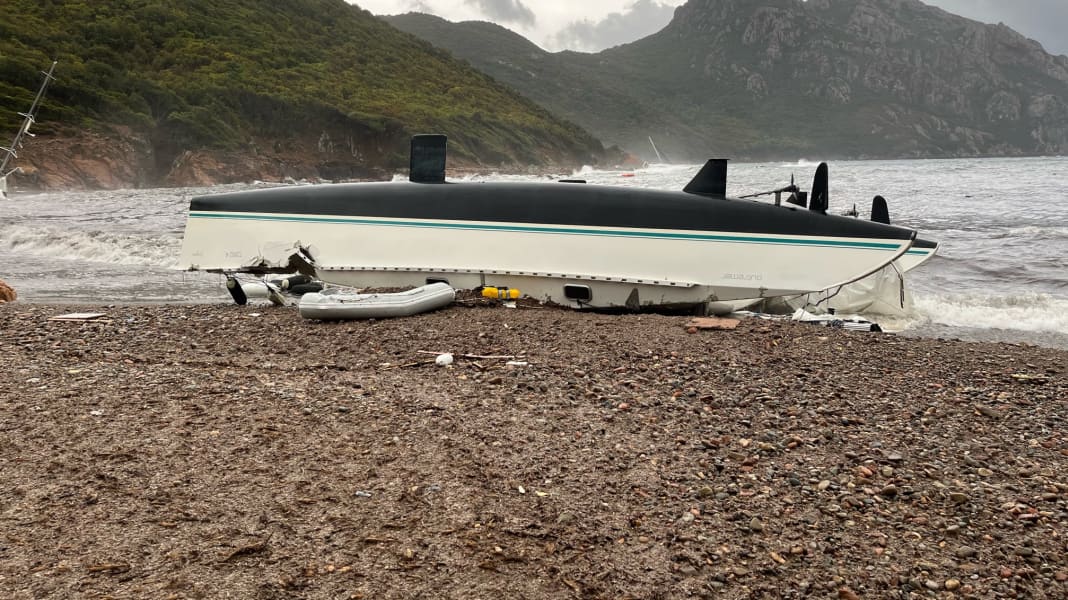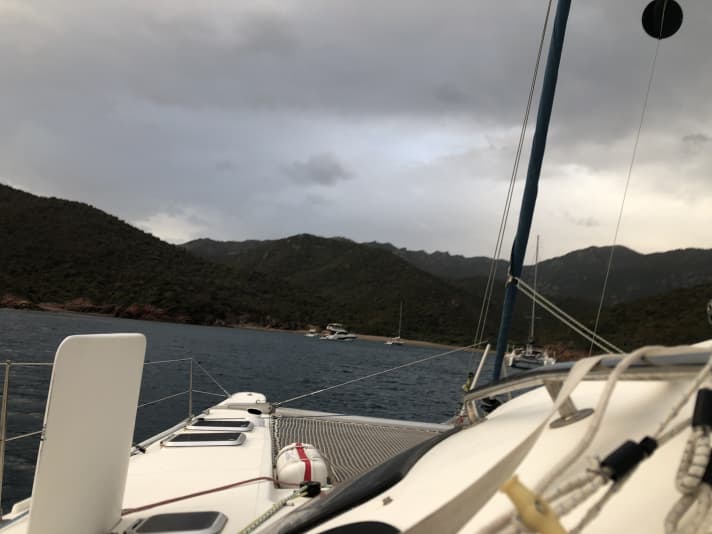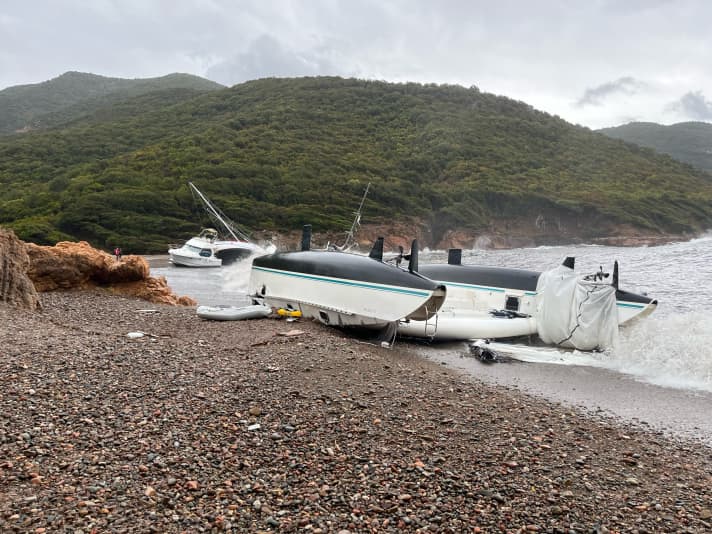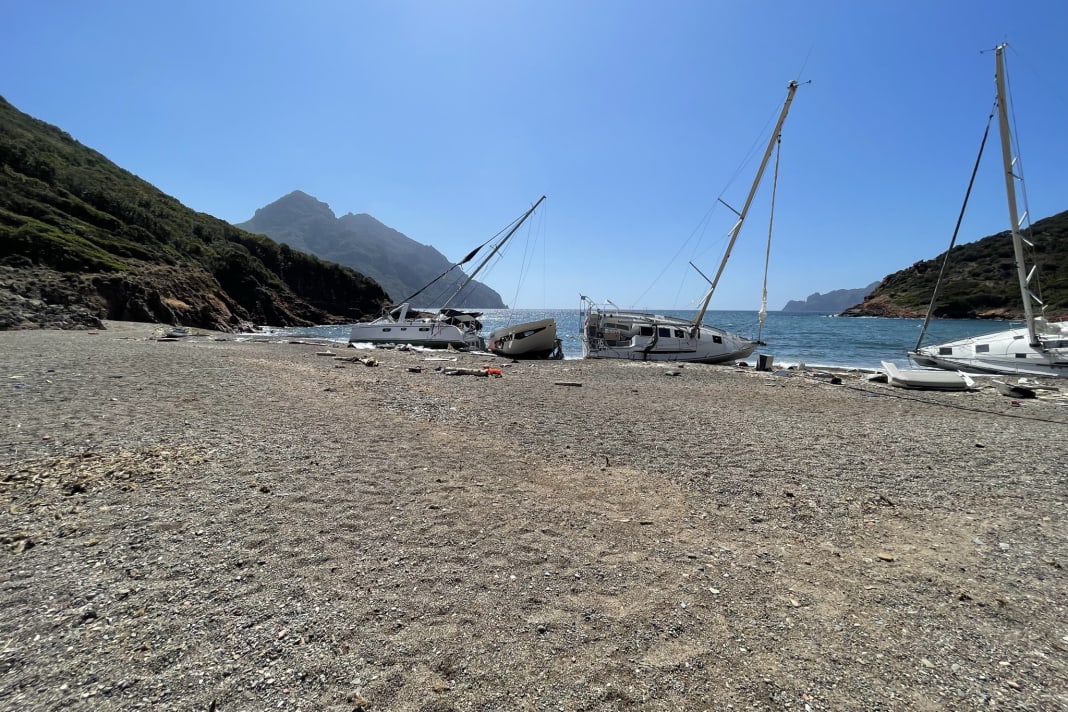
Last Thursday, a storm swept across Corsica and Italy, causing severe devastation with peak winds of 90 knots. Nine people are said to have fallen victim to it. It also left serious devastation in the marinas and anchorages. Stranded, sunken yachts, images of flying spray, owners fighting for their boats. One of them was Jesse Meyer, who anchored his catamaran in the bay of Girolata. Here he describes his terrifying experiences:

We had been travelling for two and a half weeks and so far had almost 500 nautical miles in the wake of our catamaran "Gagou". She was a light and fast 43-foot Outremer yacht, built by Gérard Danson and proudly owned by our owners (my father and I) for just under a year. Until then, we sailed an 800 Dragonfly trimaran, the boat on which I grew up and learnt to sail. From the mouth of the Rhône to Corsica, along the island to Sardinia, that was our itinerary. Every now and then we would gather a guest crew to share this great way of travelling with our friends.
We sailed from Algajola to the Gulf of Girolata on 17 August in good winds (15 to 25 knots). On board were myself as skipper, my girlfriend and a couple of friends, all aged between 22 and 28. We decided to spend the night in the bay to the east of the village of Girolata off the Plage de Tuara.
Based on the wind forecast for the evening, the night and the next morning, I thought this bay was very sheltered and suitable for an overnight stay at anchor.
I remember the forecast being north-easterly for the evening, veering north in the morning. In the evening, the wind was expected to continue for a while (up to 25 knots in gusts), calm down during the night and freshen up again in the morning (approx. 20 to 25 knots). I used two different wind forecast apps, "Windfinder" and "windy.com", to plan where to spend the night.

We dropped the anchor quite centrally in the bay, just behind and to the side of the last ship, also a high-performance catamaran, and drifted out of the bay by the length of the chain. I made sure to keep enough distance from the reef on the south-east side of the bay. After about 30 to 60 minutes, I dived to the anchor to make sure it was in a good position.
The anchor was buried deep in the sand without having moved in the previous gusts and the chain was neatly stretched out. Everything was stowed and tidy on deck.
We were expecting thunderstorms and rain for the next two days, otherwise I had no concerns about the upcoming overnight stay. We enjoyed the beautiful bay with good food and a glass of rose from the region. We didn't go to bed too late, everyone was exhausted from the day's sailing. The next morning we were woken up by light rain and a distant thunderstorm. The exact time is not known, but we think it should have been around seven o'clock, maybe later.

Shortly after I woke up, the wind picked up and I realised that it had shifted in an unexpected direction. I thought it must have been between south and south-west, definitely onshore towards the bay and not offshore as planned. I hurried into the cockpit to observe the situation and - if necessary - to be able to react if we came too close to another ship when turning into the wind or if there was a problem with the anchor. The wind continued to pick up considerably and I initially endeavoured to ensure that no objects such as cushions, chairs or tables flew out of the cockpit. I threw a few things into the saloon and noticed that the wind continued to pick up considerably in a very short time.
I shouted loudly into the deckhouse to wake everyone on board and get them to get up.
I was sure at the time that once we were back on the chain, the anchor would barely be able to hold after the ship turned. I tried to start the engines so that I would be able to act in an emergency, but I was having problems and wasn't sure if they were running yet. Looking up briefly, I realised that there was no longer any visibility and I could no longer visually orientate myself in the bay, neither to the position nor the direction of the ship.
Water whipped through the air and made it difficult to keep your eyes open.
The wind picked up incessantly to a force that I had never experienced before and would never have thought possible. According to the surveyor, we were hit by wind speeds of around 230 km/h. My girlfriend was in the cockpit next to me to help.
Our fellow sailors were just entering the deckhouse when the ship rolled over with enormous force and acceleration without warning.
At this point, "Gagou" should have been facing east or south-east. The wind came over the side of the ship and the starboard hull was lifted out of the water. We had not yet felt the expected jolt in the ship from the retensioned chain and had therefore neither turned completely nor were we hanging on to the chain when we capsized. We estimate that barely 60 seconds passed between my call to the deckhouse and the ship rolling over. My girlfriend and I surfaced outside the ship, the water already tasting of diesel.
Our co-sailors were still inside. They were thrown through the saloon and fortunately remained conscious.
Within seconds, the water was literally up to their necks. They are not experienced divers or swimmers, but after a brief declaration of courage and a kiss from the saloon, they dived into the open. After a short time, we were all on the hull facing the sea. I knew we had no chance in the open water and called on everyone to reach the hull at all costs. The boat was already moving away from us, and we only just made it with our best efforts. We held on to an aluminium rail on the outside of the hull, which had rectangular recesses that gave us a good grip, but tore our hands open. We wondered whether we could get onto the ship, but found ourselves unable to do so as the waves were getting bigger and bigger. It didn't seem possible to get around the bow or stern or directly over the hull.
We were repeatedly swept away from the boat by the waves and only just managed to get the person back again.
We called for help in vain as we drifted close to a motor yacht that was apparently still at anchor. Apart from that, we didn't see another ship. Based on the last known wind direction and the motor yacht we were drifting past, I realised that we were drifting towards land and I hoped that we would be washed up on the beach and not on the rocks. Our strength was dwindling and we were barely able to stay afloat or on the boat. According to eyewitnesses, the whole process took about 15 minutes until we reached the beach and came out from behind the boat.
Only when my friend felt sand under her feet and we were able to stand did we dare to let go of the boat and drag ourselves along the bow through the surf to the beach.

We took shelter behind a small wall from flying debris. We saw that all the ships in the bay had now been driven onto the beach or the rocks. I wanted to check on the crews for a moment, but they hadn't left their ships yet and the flying debris made it very dangerous to stay on the beach. We waited behind the wall until it was over.
In total, we saw seven ships on land in our bay and none more at anchor in the water.
After everything had calmed down again, the crews of the damaged ships in this bay slowly gathered on the beach. Nobody died in our bay, but unfortunately that wasn't the case everywhere. We gathered what belonged to us on the beach and was still useful, but unfortunately there wasn't much left. We then waited for help. I would like to take this opportunity to thank everyone who supported us. Hikers and crews from other boats gave us clothes and provided us with water, coffee and biscuits.



Fishermen and shuttle boats from Girolata picked us up from the beach, but you have to realise that Girolata and our bay are not accessible by car. The military took our friend to hospital by helicopter. Restaurants in Girolata and Porto provided all the evacuees with food and drink. Accommodation was provided by the authorities within a day, and even with certain language barriers due to our limited knowledge of French, we were always assisted by helpful Corsicans or other holidaymakers. The harbour masters from Girolata supported us right up to the end, even during further inspections of our boat. Above all, our families immediately pulled out all the stops to give us the best possible support and bring us home.
Our ship, the fulfilment of a long-cherished dream and the basis for fantastic holiday and life plans, is now gone. It brought us ashore alive and sacrificed itself for us. We will never forget that.
More about the storm over Corsica:
Videos filmed by Jesse Meyer after the accident:
At this point, you will find external content that complements the article. You can display and hide it with a click.
At this point, you will find external content that complements the article. You can display and hide it with a click.
At this point, you will find external content that complements the article. You can display and hide it with a click.

